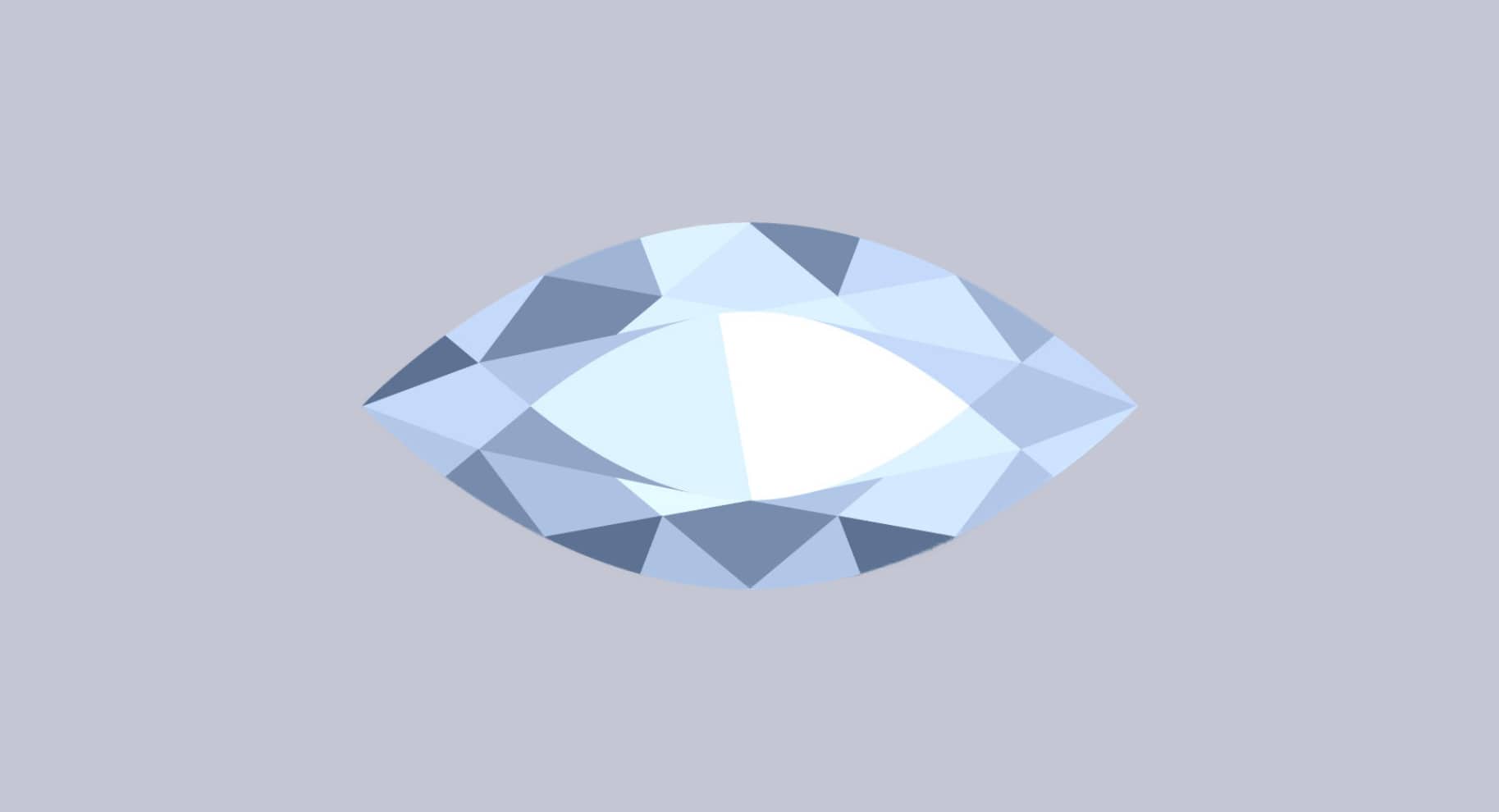The Marquise Cut has its origins in 18th Century France, where King Louis XV asked a jeweler to create a diamond in the shape of his mistress’s lips.
From these striking beginnings, the shape of this cut has evolved into the 58-facet elegant and brilliant gemstone that you can see today in the loose diamonds collections of fine diamond dealers.
- It’s also known as a navette, which means “little ship” in French.
- In the US it’s referred to colloquially as a “football” shaped cut.
- Throughout the English speaking world it’s sometimes referred to as a “boat-shaped” cut.
- But “marquise” is too good a word not to use. It’s obviously the preferred term and so that’s what we’ll use here. (Marquise was the title of nobles who ranked higher than counts but lower than dukes. Such nobles wore gemstones of this shape as a mark of their rank.)
The Marks of a Marquise Cut Diamond
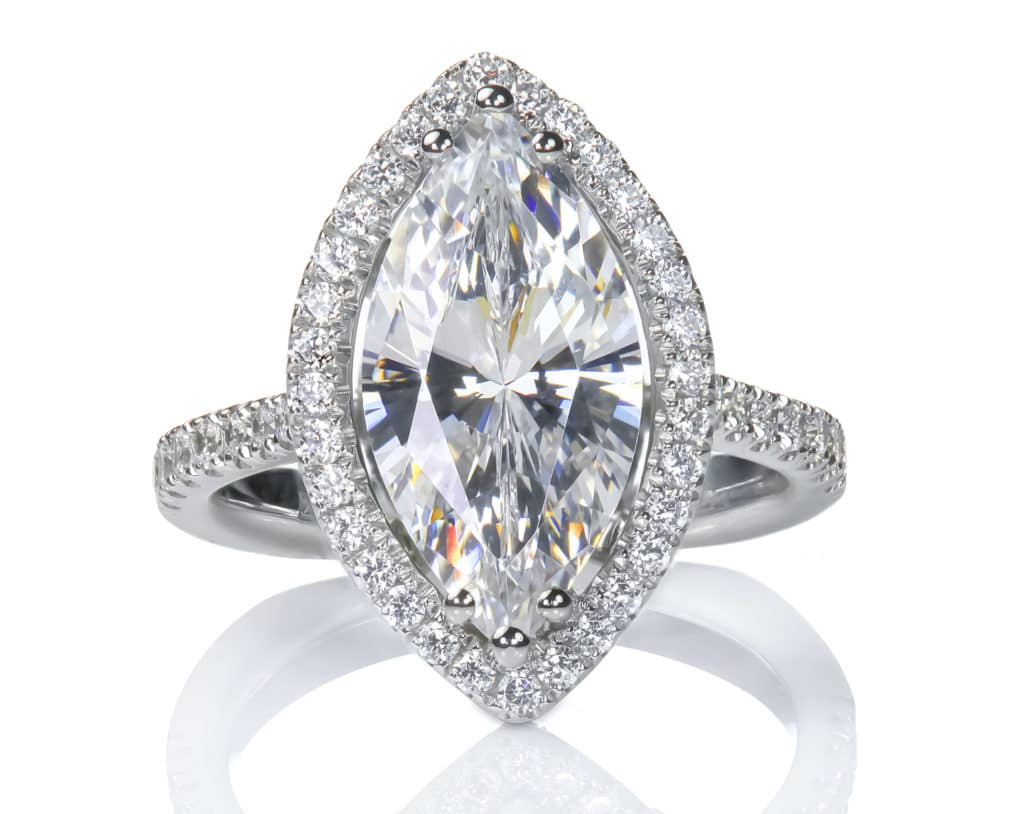
- A Marquise diamond’s 58-facet Brilliant cut makes for a lot of sparkle from its distinctive elliptical shape, with sloping sides and pointed ends.
- The table (top of the diamond) of Marquise diamond is flat, with a gently sloping crown (the part of a diamond which slopes off the table).
- The culet (the bottom of a diamond) is gently pointed down below.
- The two elongated tips are sharply pointed.
Why Couples Consider a Marquise Cut for Diamond Engagement Rings
- Because it has 58 facets, it’s classed as a Brilliant Cut. While it may not match the Round Brilliant Cut for sparkle (nothing can), it does stand out not only with brilliance but also with elegance and style.
- It has a dramatic effect, since it’s relatively unusual as a diamond engagement ring but has ties deep in the history of the nobility and royalty in France.
- It emphasizes beautifully long fingers and slenderizes shorter, heavier fingers.
- It stands out among the traditional Round Cuts and Cushion Cuts. You can notice the difference from across the room. It projects confidence (and requires it).
- Because the Marquise Cut is longer, wider, and less deep than a Round Brilliant or Cushion Cut, the Marquise Cut appears larger when it’s worn in an engagement ring. (It’s easy to forget how much of the bulk of a Round Brilliant is hidden from view. The Marquise Cut displays more of itself, hides less.)
- The Marquise Cut, like all Fancy Shape diamonds, is less expensive than a Round Brilliant or Cushion Cut of the same carat weight and clarity.
Why to Be Extra Careful With Your Observations When Shopping for a Marquise
Marquise Cut diamonds require more careful shopping than Round Brilliant Cuts.
That’s a pleasure as well as a responsibility.
One reason is that Round Brilliant Cut diamonds are fully graded by the GIA (Gemological Institute of America) and/or by the AGS (American Gem Society).
Marquise Cuts (like all Fancy Shape diamonds) are graded by the GIA. But they are not as fully graded as are Round Brilliants.
- Marquise Cuts receive a Color grade.
- They receive a Clarity grade.
- They receive a certified Carat specification.
- But they do not receive a “Cut quality grade” from the GIA, AGS, or any other universally respected grading lab.
Why Don’t These Labs Fully Grade Marquise Cuts?
Because predicting the light performance of specific Fancy Shape diamonds has proven too difficult so far for the labs to figure out.
And respected labs such as the GIA and AGS pride themselves on objective criteria for Cut.
If these labs don’t have the evidence to predict performance, then they won’t. That’s a refreshing amount of integrity, and in my opinion it’s why consumers and sellers of diamonds rely on the GIA and AGS above all other diamond grading entities.
The labs can predict the light performance of Round Brilliants, but not of Fancy Shape diamonds. (All shapes except Round Brilliant are known as Fancy Shape diamonds.)
What Does This Mean?
It means you can’t rely on anyone to tell you what a good Cut quality of a Marquise Cut is.
You just have to be more observant.
Fortunately, you can easily be more observant, and with pleasure, because we live in a golden age of online diamond shopping. The prices are a little lower online, the service is better in many ways, and the ability to see many diamonds quickly is unparalleled in the brick and mortar world.
Your ability to observe the diamonds offered for sale is exquisite, with the imaging technology at James Allen and Blue Nile, for example.
Here’s What to Look for When You’re Looking at Marquise Diamonds
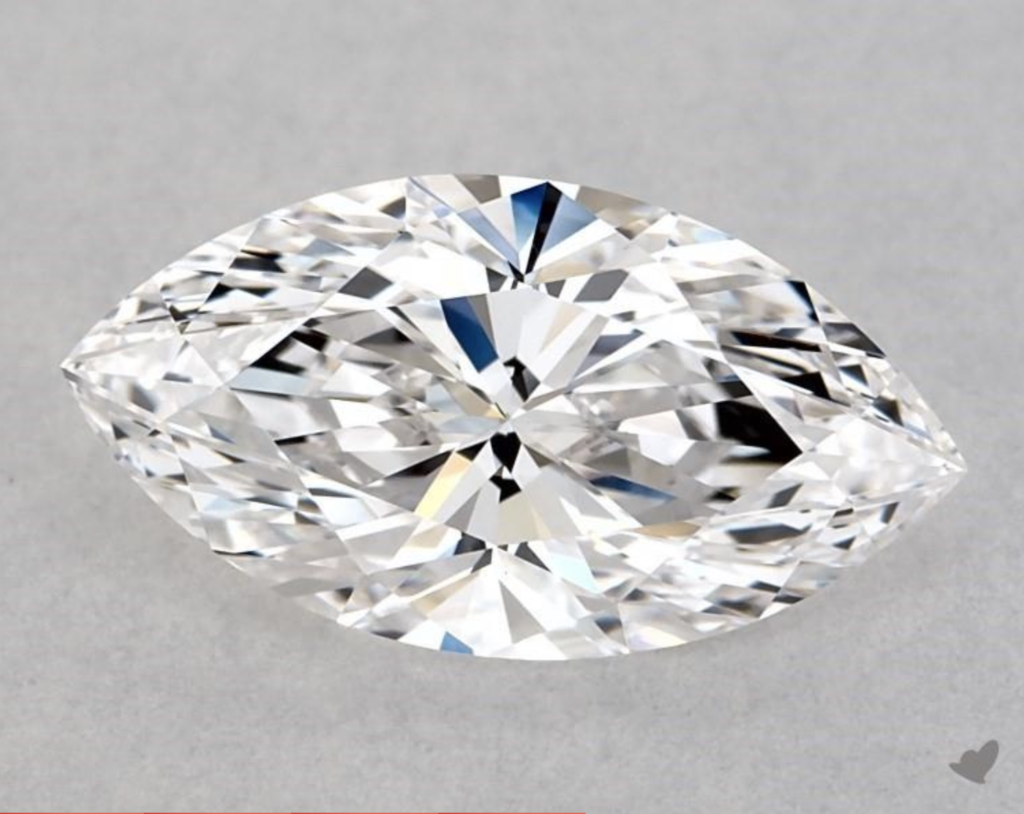
- Symmetry – If a Marquise diamond isn’t symmetrical, people will notice.
- The table – It should not be too small. Nor too large. Too small is the more common flaw. You can see, in poorly cut Marquise diamonds, that the table covers less surface area than the crown.
- Look at the points – Are they perfectly opposite each other? Are they perfectly aligned, vertically as well as horizontally?
- Look down through the table (top of the diamond) – Is the culet (bottom point of the diamond) visible as right through the middle of the table? It shouldn’t be “wobbly” as if it’s off center.
- Look at the culet (bottom point of the diamond) from the side – Is it nicely formed. It is located right in the middle between the two points?
- Look at the outline of the table (top of the diamond) facet – Are the lines even and symmetrical?
- Look at the sides, from the top – Are they a smooth arc of closely placed facets? Or are they somewhat misshapen? If something looks off, even if you can’t put your finger on it, mark that diamond off your list.
- Look for a “bowtie” effect – You do this by looking straight down through the table (top of the diamond). A bowtie effect is a trick of light. Only, it’s a bad trick, because it’s when two blobby shadows appear to cross the Marquise Cut like a bowtie. Most people see this effect as undesirable. It only appears at that one viewing angle. But it’s a pretty important viewing angle, since it’s the most common angle from which to enjoy a diamond.
- Look for brilliance – It won’t have quite as much brilliance (quantity of light flowing up through the table and crown) or fire (rainbow effects) as a Round Brilliant. Some diamonds, such as an Emerald Cut, aren’t meant to be brilliant and don’t pretend to be. But a Marquise Cut diamond is a Brilliant cut. So the brilliance should be impressive.
- Observe each facet for polish – Are there blemishes (flaws on the outside of the diamond)? The GIA diamond grading report should have already noted these, so you don’t have to quite as vigilant about spotting them for yourself. Still, it’s an important purchase, and you want to know your diamond for yourself, not for just what a professional noted on paper. (No human is perfect. Not even a professional. And no other human is you. So be sure that you are pleased, not just that a certificate said something.)
- Inclusions – Also less urgent, because these too should be noted on the GIA diamond grading report, look for inclusions (internal flaws of a diamond). Are they visible from the top? Not good. Pass on that diamond.
- Tips should be perfect – Of special importance, check the tips for blemishes (external flaws) or inclusions (internal flaws). The tips of Marquise diamonds are points of weakness. Yes a diamond is the hardest mineral. But they’re not indestructible. Especially sharp points. And especially sharp points with any flaws. They can chip or break, especially if flawed.
- Length-to-width ratio – Although it’s tempting, it’s never smart to shop by numbers. That’s like painting by numbers, and it often leads to bad results. But some numbers can be guides. It’s best to stay within a length-to-width ratio of between 1.75 and 2.20. Length-to-width ratio is listed in the specifications of any diamond at James Allen (look under “Product Details”) or Blue Nile (look under “Diamond Details”).
What to Look for in the Color of Marquise Cut Diamonds
Round Brilliant Cut diamonds can hide their color somewhat. They bring so much light through to the table and crown that they can appear to be a Color grade higher than they actually are.
Not so with a Marquise Cut.
A Marquise diamond shows its true color. Although the Marquise is brilliant, it doesn’t quite match the cooling brilliance of the Round Brilliant.
So if you prefer an icy, colorless, perfect beauty, be prepared to sacrifice a little carat weight in order to stay on budget while paying for a high clarity diamond.
On the other hand, most couples opting for a Marquise are comfortable going their own way. They’re confident. So they may opt for a less traditional I or J color. Not because they’re less expensive, but because they’re more confident.
They may even for a Fancy color.
What to Look for in the Clarity of Marquise Cut Diamonds
Marquise Cut diamonds will show their true Clarity more easily than will Round Brilliant diamonds. And for the same reason mentioned above about Color.
Round Brilliant diamonds can obscure some small inclusions by the amount of light that pours upward through the top of the diamond.
Marquise diamonds are Brilliant, too. They can obscure some small inclusions (flaws). But in general, they have less brilliance than Round Brilliants, and a larger table (top of the diamond). So whatever small flaws may be in the diamonds (and every diamond has some) will be more readily “visible.”
I put quotations around “visible” because I want to emphasize that flaws in a diamond aren’t easily noticed without a jewelry loupe.
When it comes down to what you both really want, it’s probably the largest and most beautiful diamond, representing your personalities and relationship, that you can find.
You probably also have a budget.
So it’s only logical and sensible that you’d opt for a larger carat weight and a lower official Clarity score, as long as any inclusions (flaws) are invisible to the naked eye, from a distance of a couple of feet.
Don’t shop by the Clarity score alone. It’s just a number. What’s important is whether flaws are visible.
Two VS2 diamonds can look radically different, depending on where the inclusions are located. For example, is there an inclusion just under the table (top of the diamond), right in plain view? Or is it deep in the culet (bottom point of the diamond)? Can the inclusion (flaw) be concealed by a setting?
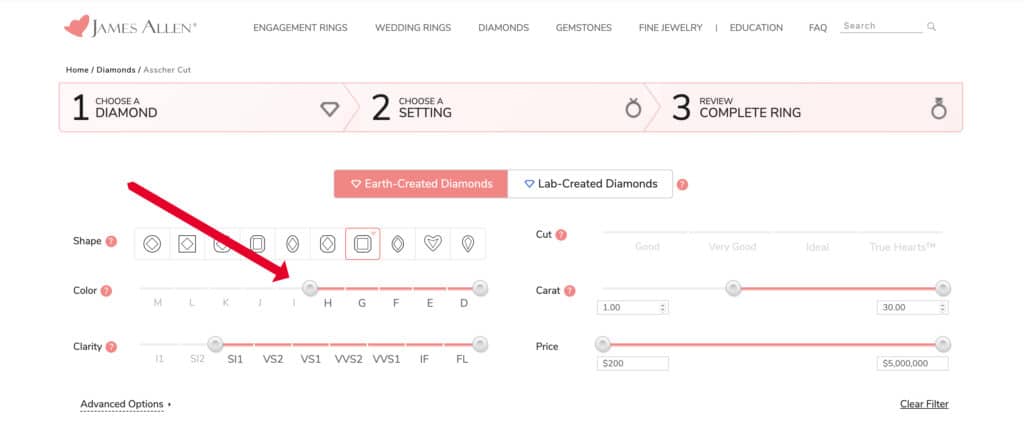
Every diamond is unique. Fortunately at James Allen and Blue Nile, the imaging technology allows you to minutely each diamond that catches your eye.
Settings for Marquise Cut Diamonds
Consider also the setting you choose. A nearly colorless Marquise diamond often pairs well with white gold or platinum.
Yellow gold would tinge the pure colorlessness of a Marquise Cut, more than with a Round Brilliant.
A warmer color of Marquise Cut can pair very well with yellow gold.
Protect the tips. Many settings for Marquise Cut diamonds specifically protect the tips, because they’re vulnerable to chipping.
Halo settings for Marquise cut diamond engagement rings are incredibly effective and striking. They make an already dramatic diamond shape even more dramatic. Halo settings also make a Marquise Cut seem even larger.
Plus, if you choose Round Brilliants for the diamonds to surround the Marquise cut, you’ll see such a pouring forth of beautiful sparkling light that the diamond will be noticeable from across any room.
For example, look at how the sparks fly from this beautifully set Marquise diamond at James Allen.
Enjoy Comparison Shopping
The incredible imaging technology at James Allen and Blue Nile, among others, makes comparison shopping for diamonds enjoyable and organized.
You can on a single page at James Allen substitute a Marquise Cut for a Round Brilliant Cut, and see the differences in price.
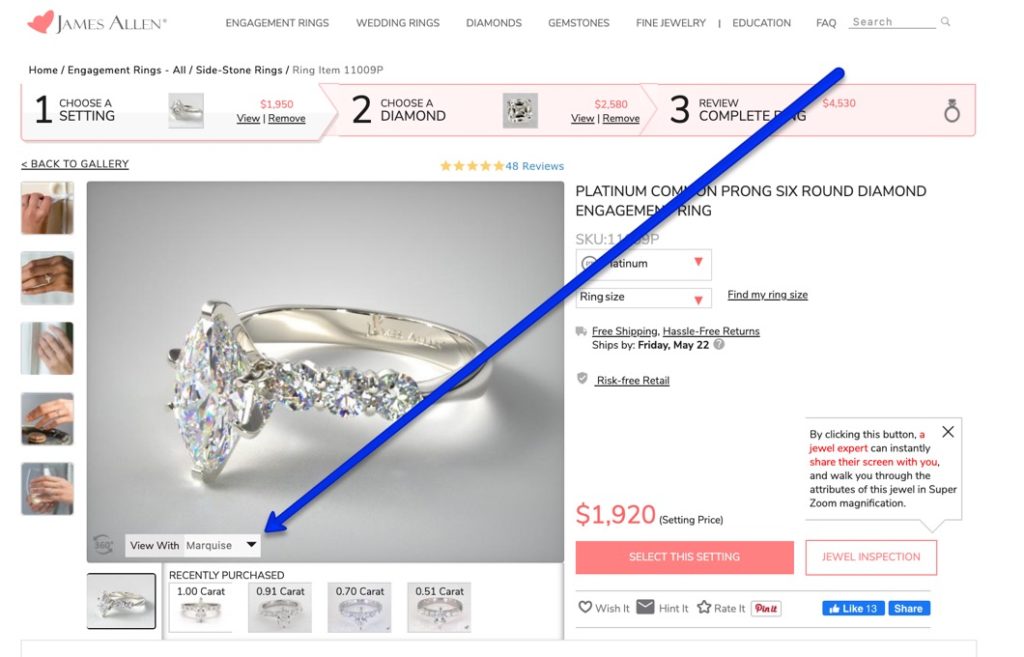
What you’ll see is that you can get a larger diamond, which appears even larger than it really is, and is just as beautiful and striking, for less money than a Round Brilliant.
The money is not the first motivation for people who love Marquise Cut diamond engagement rings. Rather, it’s the dramatic style.
A Marquise Cut diamond engagement ring is not for everyone.
But it might be for you and your beloved.
Even if you ultimately decide not to go for a Marquise cut, you’ll enjoy the time you spent looking at this elegant, historically remarkable cut of diamond.
Want My Feedback?
If you want my feedback or opinion on anything to do with diamond engagement rings, don’t hesitate to contact me.
You’ll get a personal response, and there’s no obligation.
